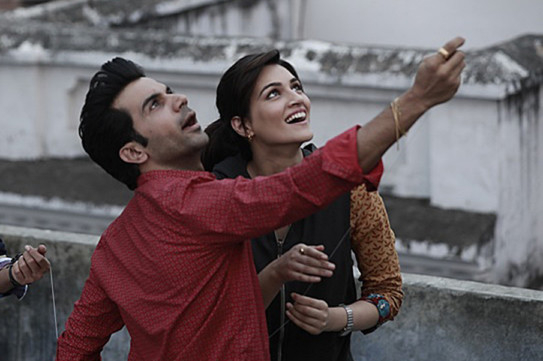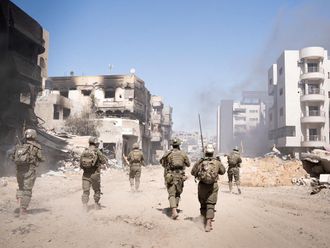
It’s perhaps time to trade your sundae with a barfi (a milk sweet), that four-cylinder mean machine with a humble two-wheeler, and those cropped tops with some humdrum cotton fare in nine yards.
We are talking about Bollywood and going by the current trend sweeping the commercial Hindi film industry in India, the all-too-familiar, glossy, ‘happily-ever after’ storyboard is making way for a more cut-and-dried rendition of life and dreams in matt finish!
Move over the archetypal ‘angry young man’, those outstretched arms on the slopes of scenic Alps, the candy-floss lover boy and that melt-in-your-mouth look of a city-bred lass ... for Bollywood has finally turned the tale on its head and how!
Just ask yourself this question: When did you last see the female lead in a Hindi film fight for a quick drag of a half-burnt cigarette with her — father?! Chances are, you never did. And it is precisely for this shock-treatment that one starts developing a liking for that free-spirited teenager ‘Bitti’ in Bareilly Ki Barfi, played to perfection by an effervescent Kriti Sanon.
Over the last one year or so, an industry that has always been known to serve a slice of life that borders on grandiose wish-fulfilment — with very generous dollops of ‘willing suspension of disbelief’ making for realism — is suddenly waking up to a refreshing new brew. Content is king and style is now the mantlepiece of a largely deglamourised depiction of the contemporary socio-cultural milieu in the world’s largest film-producing country. From Anaarkali of Arrah to a Mukti Bhawan; from Bareilly Ki Barfi to Tumhari Sulu ... the list is long and encouraging enough for one to notice a distinct shift from the song-and-dance and baddy-gets-bashed-up routine of commercial Hindi cinema to a more esoteric mode of art imitating life.
And the results are fascinating.
That onscreen shabby sweet shop in the hinterlands of Uttar Pradesh (Bareilly Ki Barfi) can now give the Café Coffee Days in upscale metropolises a run for their money when it comes to cinema being representative of an aspirational leap, that magic pill whose therapeutic appeal can enthral and entice a prince and a pauper in equal measure — all at the same time. Or for that matter, consider housewife Sulochana’s (Tumhari Sulu) trials and tribulations and her leap of faith to conquer a higher plane of existence — without the trappings of designer chiffon! This is Bollywood’s true-to-life — and not larger-than-life — rendition of a sensory experience where a hotel in unassuming Varanasi (Mukti Bhawan) effortlessly captures the charm of a transit point between ‘this’ world and ‘the other’, as a soul is torn between familial commitments on one hand and the call for an existential stock-taking on the other — compounded by an older generation’s obsession with a peaceful ‘passage’.
In that sense, Bollywood has well and truly turned the corner. The medium has remained the same, the primary objective also continues to be the same — to entertain. But the delivery mechanism has been exponentially transformed — from being loud, over-the-top and even garish at times to something that grabs you with its rustic hue and an air of freshness that is almost subliminal. And complementing it is a brave new band of almost unheard-of filmmakers who are not in the least apologetic or coy about showcasing an India that comes alive in all its squalor, chaos, small-talk and paranoia. Ashwiny Iyar Tiwari (Bareilly Ki Barfi), Suresh Triveni (Tumhari Sulu), Shubhashish Bhutiani (Mukti Bhawan), Avinash Das (Anaarkali of Arrah) are just a few of the new-age directors whose works have reaffirmed the truth that substance can never be subservient to form.
In a way, the present-day Bollywood ensemble marks an almost 180-degree shift from films such as Deewar, Sholay (both 1975) and Don (1978). Those comprised shock-treatments, too, for audiences who were still coming to grips with the ‘angry young man’ cult, as Amitabh Bachchan exploded on screen, after Hindi cinema had, for decades, serenaded the classic romantic hero in the form of a Rajesh Khanna or a Devanand. Films such as Deewar and Don marked a clear break from the norm of presenting cinema as a vehicle for commuting to that never-never land of an ideal existence. Instead, these films took up the cudgels against myriads of social injustices and the ills of an economy that was torn between its socialist commitments on one hand and the hiatus between ‘haves’ and ‘have-nots’ on the other. Thus, the ‘angry young man’, taking on the darker shades of an anti-hero at times, became the preferred delivery mode from chaos to cosmos. Empowered by the conceptual-construct of what the man on the street had always aspired to be but never quite managed it, the ‘hero’ emerged as the one-stop shop for all things aspirational and the preferred vehicle even for a moral deliverance at times!
In the meanwhile, ‘airings’ in the shape of rom-coms such as a Jab Jab Phool Khile or Dilwale Dulhania Le Jayenge kept the box-office cash registers ringing.
And the trend continued for nearly five decades.
But formula films were clearly past their sell-by date and the glitzy representation of life on 70mm had to move on to the next chapter. What we are seeing now is perhaps a culmination of two developments that are independent of one another conceptually, but linked by a temporal umbilical cord.
The new generation in India’s hinterlands and dust bowls is setting aspirational goals that are no longer tied to the baggage of social ostracism of any sort. This is a new India that can and must find answers to decades of skulduggery and socio-economic debauchery, that had made the culture of living on handouts the accepted social norm. Those marginal beings relying on a subsistence level of living have probably realised that they ought to look beyond the seeming inevitability of handouts. This quantum leap in aspiration has coincided with the technology boom that has transformed, for instance, a mobile handset from being an obscure object of desire lodged in some distant star to an everyday necessity of here and now.
And fortunately, Bollywood is only being representative of that mood for change. It is only being reflective of that urge to seek a clearer, more holistic view of life and times — not necessarily through the ‘angry young man’s’ or the anti-hero’s impossible stunts, but through a plebeian’s honesty to ask a few probing questions and confront the truth as it is and not what it could or should have been. And this urge plays itself in all humility, exposing even the fallibilities of human nature with aplomb — not with a shade of guilt or embarrassment. It is this urge to see life in matt finish that has helped even an established star such as Aamir Khan find so much traction with the audience in his pot-bellied avatar of a senior citizen in Dangal or a Kangna Ranaut to be the queen of hearts in Queen — a small-town girl with a king-size dream — or a Rajkumar Rao to convince the audience in Bareilly Ki Barfi that there are times when the joke is on the hero.
Thematically too, Bollywood offerings have been unabashed with their explorations in recent times. From the need to raise awareness on the problems of open defecation (Toilet Ek Prem Katha) to a nautch-girl’s panache and self-respect in a male bastion (Anaarkali of Arrah), Bollywood of 2017 is a far-cry from the fire-and-brimstone of the 1970s, ‘80s and ‘90s.
And we are not done yet. Come the New Year, Padman promises to hit the screens with an even bolder message: The need for menstrual hygiene.










